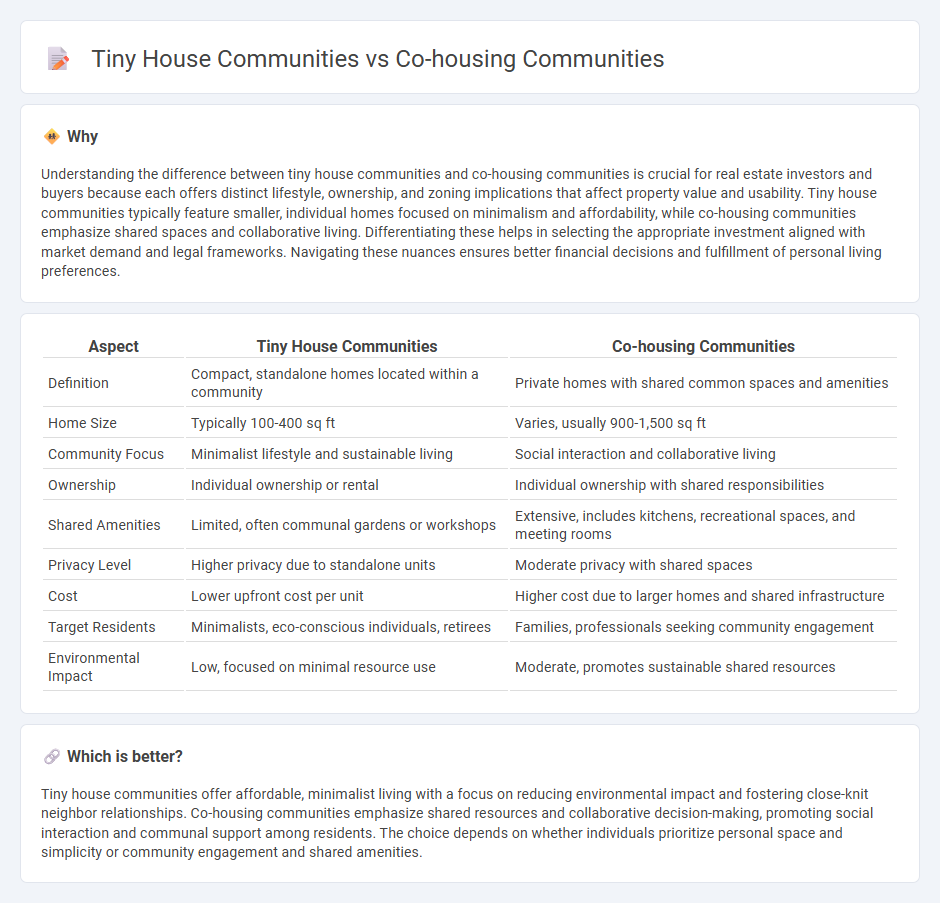
Tiny house communities emphasize compact, affordable living with individual units that maximize space efficiency and promote minimalist lifestyles. Co-housing communities focus on shared resources, collaborative decision-making, and fostering social connections through communal spaces and activities. Discover the unique benefits and lifestyle opportunities of both tiny house and co-housing communities to find the perfect fit for your real estate preferences.
Why it is important
Understanding the difference between tiny house communities and co-housing communities is crucial for real estate investors and buyers because each offers distinct lifestyle, ownership, and zoning implications that affect property value and usability. Tiny house communities typically feature smaller, individual homes focused on minimalism and affordability, while co-housing communities emphasize shared spaces and collaborative living. Differentiating these helps in selecting the appropriate investment aligned with market demand and legal frameworks. Navigating these nuances ensures better financial decisions and fulfillment of personal living preferences.
Comparison Table
| Aspect | Tiny House Communities | Co-housing Communities |
|---|---|---|
| Definition | Compact, standalone homes located within a community | Private homes with shared common spaces and amenities |
| Home Size | Typically 100-400 sq ft | Varies, usually 900-1,500 sq ft |
| Community Focus | Minimalist lifestyle and sustainable living | Social interaction and collaborative living |
| Ownership | Individual ownership or rental | Individual ownership with shared responsibilities |
| Shared Amenities | Limited, often communal gardens or workshops | Extensive, includes kitchens, recreational spaces, and meeting rooms |
| Privacy Level | Higher privacy due to standalone units | Moderate privacy with shared spaces |
| Cost | Lower upfront cost per unit | Higher cost due to larger homes and shared infrastructure |
| Target Residents | Minimalists, eco-conscious individuals, retirees | Families, professionals seeking community engagement |
| Environmental Impact | Low, focused on minimal resource use | Moderate, promotes sustainable shared resources |
Which is better?
Tiny house communities offer affordable, minimalist living with a focus on reducing environmental impact and fostering close-knit neighbor relationships. Co-housing communities emphasize shared resources and collaborative decision-making, promoting social interaction and communal support among residents. The choice depends on whether individuals prioritize personal space and simplicity or community engagement and shared amenities.
Connection
Tiny house communities and co-housing communities are connected through their shared emphasis on sustainable living, communal resources, and reducing individual environmental footprints. Both housing models prioritize collaborative spaces, fostering social interaction while maximizing efficient land use in real estate development. These innovative community designs address affordable housing challenges by combining private living units with shared amenities, promoting a balance between privacy and community engagement.
Key Terms
Co-housing Communities:
Co-housing communities emphasize shared spaces and collaborative living while maintaining private residences, fostering strong neighborhood bonds and sustainable lifestyles. These communities often include shared kitchens, gardens, and common areas designed to support social interaction and resource efficiency. Explore more about how co-housing can transform your living experience with social connectivity and sustainability.
Shared Amenities
Co-housing communities feature extensive shared amenities such as communal kitchens, gardens, and recreational spaces designed to foster social interaction and cooperative living. Tiny house communities offer shared amenities too, but often prioritize minimalistic, multifunctional common areas to complement the compact private units. Explore the unique advantages of shared amenities in co-housing and tiny house communities to find the best fit for your lifestyle.
Consensus Decision-Making
Co-housing communities emphasize consensus decision-making to foster collective ownership and shared responsibility among residents, promoting inclusive participation in community governance. Tiny house communities may adopt consensus methods less frequently, often relying on simpler decision-making structures due to smaller group sizes and individual autonomy. Explore comprehensive analyses comparing governance models in co-housing and tiny house communities for a deeper understanding of consensus application.
Source and External Links
Cohousing - Cohousing is an intentional community where residents live in private homes with shared spaces, promoting social interaction and cooperation.
Beyond Contact-Intergenerational Living in Cohousing Communities - This article discusses how cohousing communities foster intergenerational connections through shared facilities like gardens and common houses.
The Cohousing Association of America - The Cohousing Association of America highlights the benefits of cohousing, including supportive neighbors and shared spaces, while addressing affordability challenges.
 dowidth.com
dowidth.com